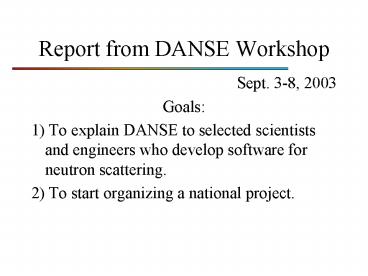Report from DANSE Workshop - PowerPoint PPT Presentation
1 / 14
Title:
Report from DANSE Workshop
Description:
Cases from casual to expert users. Leveraging knowledge of senior scientists ... Cases from casual to expert users. 4. Cost Effective for Neutron Facilities ... – PowerPoint PPT presentation
Number of Views:47
Avg rating:3.0/5.0
Title: Report from DANSE Workshop
1
Report from DANSE Workshop
- Sept. 3-8, 2003
- Goals
- 1) To explain DANSE to selected scientists and
engineers who develop software for neutron
scattering. - 2) To start organizing a national project.
2
Attendees
- Persons
- Michael Aivazis, Simon Billinge, Paul Butler,
Brent Fultz, Garrett Granroth, Gayle Greene, Nick
Hauser, Jason Hodges, Tim Kelley, Paul Kienzle,
June Kim, Przemek Klosowsky, JaeDong Lee, Mark
Lumsden, Mike McKerns, Ray Osborn, Peter
Peterson, Lee Robertson, Frans Trouw, Ersan
Ustundag, Xun-Li Wang, Mohana Yethiraj - Specialties
- diffractometry, SANS, inelastic scattering,
engineering diffraction, reflectometry, software
engineering
3
Reasons to do DANSE
- 1. Better Science
- - More science (efficiency, use of beamtime)
- - New science (extensibility)
- - Connection to modern theory
- 2. Ease of Use
- Cases from casual to expert users
- Leveraging knowledge of senior scientists
- 3. Ease of Development
- Cases from casual to expert users
- 4. Cost Effective for Neutron Facilities
- - less duplication of effort, easier user
support, universal look and feel - 5. Time is Right
- Grid is coming and needs scientific applications
- Potential for growth internationally, and into
other fields such as x-ray techniques - Framework from ASCI
- SNS is a fresh opportunity to do coherent
software
4
What Is the DANSE Architecture?
- An integration system to glue together data
analysis software, offering - - Ease of use at all levels of user expertise
- - Extensibility (modular)
- Distributed and standalone computing
- An open source project
5
What Is the DANSE Project?
- The incorporation of present software
capabilities into a broader system, and sometimes
using the existing packages themselves (DAVE,
ISAW) - The development of powerful software to enable
new science from the instruments at the SNS - A collaborative effort between software
professionals, neutron scattering scientists, and
facilities - An open source project
6
What DANSE is Not
- A barrier to using existing tools
- An exercise in high-performance computing
- A rewrite of DAVE, ISAW, or other packages
- Dependent on a remote server
- More money for the ARCS instrument
7
DANSE Project Has Two Parts
- 1. Science-Based Subprojects
- Inelastic (ARCS)
- Diffraction
- Engineering Solid Mechanics
- Reflectometry
- SANS
- 2. An Infrastructure of Central Services
- Software Framework
- Integration of Science Sub-Projects
- Hardware
8
Organizational Structure of DANSE Project
9
Science Sub-Projects Shall
- Prioritize Software Needs
- Ensure Availability of Existing Capabilities
- Rebuild Them as Needed for Ease of Use
- Envision and Build New Approaches for Data
Analysis - Strong Preference for Real Data from an Existing
Instrument
10
Central Services Shall
- Coordinate and Integrate the Products of the
Scientific Subfields - Design and build
- - Modular Components
- - Data Streams
- - Distributed Analysis System and compatibility
with standalone capabilities - Prototype Hardware and Software Facilities
- Educational and Consulting Role for Subprojects
- Release Management
11
Programming Languages
- The following can be used within DANSE
- Python
- C, C
- Fortran
- Java, Tcl
- Environments (Matlab, IDL, Igor)
- New codes will be developed in
- Python, C, C, Fortran
12
User/Developer Interfaces
- GUI 1 (basic buttons)
- GUI 2 (Visual Programming Environment)
- Python command line (analysis packages)
- Developer tools
13
DANSE Steps for Sub-Project Leaders
- Prioritize the existing analysis methods in your
field - Informed consensus is best, but guesses may
suffice - Emphasize analysis needs, not means to the ends
- Develop a budget for a 3-person team
- Write a 5-page sub-proposal
- Expect iteration.
14
DANSE Steps for Brent and Michael
- Rewrite the DANSE white paper (more Why, less
What) - Develop a full project plan (Scope. Effort
estimation, e.g. graphics) - Management plan (scenarios depend on funding)
- Early distributions of
- - stream protocols for histograms, tables, and
XML data - - plan for server installation of a Python
package from each sub-group - - DANSE client software distribution plan
- Coordinate with Ian the letters of support and
visits to NSF and DOE































